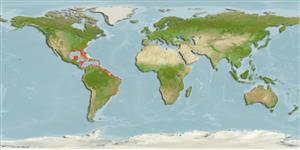Environment: milieu / climate zone / depth range / distribution range
Ecologia
marinhas; estuarina associadas(os) a recifes; intervalo de profundidade ? - 48 m (Ref. 9710). Subtropical; 42°N - 35°S, 98°W - 34°W
Western Atlantic to Southwest Atlantic: Rhode Island, USA to southeastern Brazil.
Length at first maturity / Tamanho / Peso / Idade
Maturity: Lm 10.8 range ? - ? cm
Max length : 38.8 cm TL macho/indeterminado; (Ref. 26340); common length : 20.0 cm TL macho/indeterminado; (Ref. 3821); peso máx. Publicado: 400.00 g (Ref. 5217)
Espinhos dorsais (total): 0; Raios dorsais moles (total): 11-12; Espinhos anais 0; Raios anais moles: 11. Greenish above, pale yellow to white below; back has series of pale lines and arcs suggesting concentric circles with intersecting lines. No other puffer has this color pattern (Ref. 26938).
Commonly found in bays, tidal creeks and protected coastal waters, especially on seagrass beds, and in brackish water. Rare or absent on coral reefs. Does not form schools, but may form huge aggregates. Hides in the sand when frightened (Ref. 9710). Feeds mainly on bivalves, gastropods, foraminiferans and several other benthic invertebrates specially crustaceans, which it crushes with its powerful teeth (Ref. 35237). To ward off predators, it inflates itself like a balloon. Highly toxic; used to poison cats and dogs (Ref. 2861).
Spawning season is from late spring to early fall at Biscayne Bay, Florida. Mean length at first maturity is over 13 cm TL.
Robins, C.R. and G.C. Ray, 1986. A field guide to Atlantic coast fishes of North America. Houghton Mifflin Company, Boston, U.S.A. 354 p. (Ref. 7251)
Categoria na Lista Vermelha da IUCN (Ref. 130435)
Ameaça para o homem
Poisonous to eat (Ref. 3821)
Utilização humana
Pescarias: sem interesse
Mais informação
ReferênciasAquaculturaPerfil para aquaculturaEstirpesGenéticaElectrophoresesHereditariedadeDoençasProcessamentoNutrientsMass conversion
ColaboradoresFotografiasStamps, Coins Misc.SonsCiguateraVelocidadeTipo de nataçãoÁrea branquialOutras referênciasCérebrosVisão
Ferramentas
Warning: mysqli::__construct(): (HY000/1040): Too many connections in /var/www/html/includes/speciessummary.lib.php on line 2414
Can't connect to MySQL database fbquizv2. Errorcode: Too many connections
